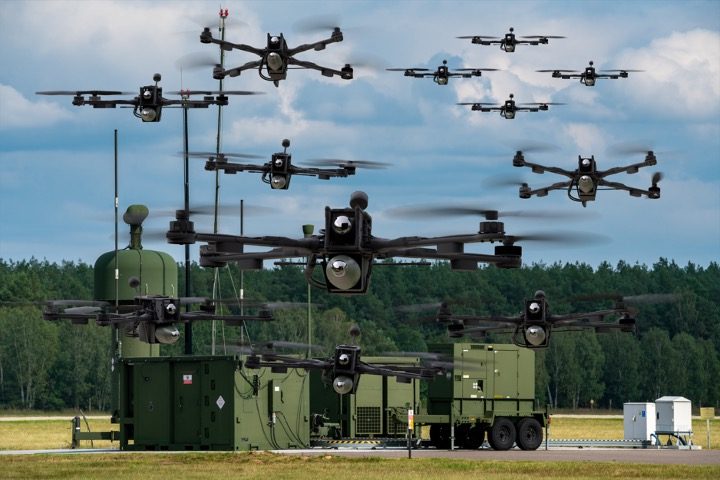
Paris plans to boost Kyiv’s own military industry instead of continuing to send equipment to the country, the French envoy to Ukraine, Gael Veyssiere, declared on January 2.
France has offered Ukraine over €3.2 billion ($3.51 billion) worth of military aid, including 30 Caesar self-propelled howitzers, light tanks and armored troop carriers, and anti-tank and air-defense missiles, as well as “several dozen” Storm Shadow long-range missiles.
Speaking with radio broadcaster France Info, Ambassador Veyssiere said that President Emmanuel Macron’s government intends to continue its strategy of supporting Ukraine.
“[The strategy] will gradually change its nature since the objective is to produce more weapons in Ukraine, rather than proceeding solely through donations or purchases,” Veyssiere said, noting that it will “take a little time” for the policy to shift. He noted that 2024 would be “the year when arms production in Ukraine must increase and when Ukraine must be able, more and more, to count on its own resources, produced on its territory.”
The French ambassador’s comments reinforced the stance that Washington has taken for the past several months, as the amount of weapons from the United States and its allies that could be sent to Kyiv is declining.
Last month, the U.S. government announced that it plans to create an interagency “deal team” and appoint a special advisor to Ukraine’s Ministry of Strategic Industries to boost weapons production and counter corruption.
The announcement came after the first day of the U.S.-Ukrainian Defense Industrial Base Conference in Washington, which assembled over 300 government and industry representatives with the aim of “significantly increasing” arms and ammunition production inside Ukraine.
Back then, the White House indicated that the State Department will send a congressionally approved advisor to Kyiv to “support and accelerate Ukraine’s transition to an interoperable military force, combat corruption, and attract foreign investment in critical industries.”
Defense, Commerce, and State Department officials already on the “Ukraine Deal Team” will “support industry, Ukrainian, and other partners” with “guidance” regarding potential deals and export requirements for Kyiv’s military industry.
The term “interoperable” has typically been employed to refer to a military using former Soviet equipment and doctrine “transitioning” to NATO standards. Over the past 20 months, the United States and its allies have tried to replace Ukraine’s battlefield losses with Western arms and equipment, with each new system being lauded as a potential “game changer” in the conflict with Russia.
Based on revelations from the White House, the Pentagon and the U.S. military industry have already supplied Ukraine technical data to “start local production of some of the FrankenSAM projects,” alluding to the practice of using Western munitions in Soviet-designed air-defense systems.
At the moment, Russia is targeting Ukraine’s surviving military-industrial complex with heavy drone and missile strikes, especially facilities for production of missiles and drones and warehouses storing the long-range missiles provided by the West to Kyiv.
Russia’s bombing campaign came after a Ukrainian missile strike on the Russian city of Belgorod, which killed 25 civilians, including children, and injured 100 more. Some of the Western-supplied arms were used in Ukraine’s attack.
When questioned about the Belgorod massacre, Veyssiere maintained that “Ukraine is defending itself.” The French ambassador also pointed out that Kyiv “has the means” to implement Volodymyr Zelensky’s pledge to “ravage” Russia.
“President Zelensky announced that Ukraine would produce one million Ukrainian drones in 2024. And besides, Ukraine is not alone. It is helped by friendly and partner countries who help it equip itself with military equipment,” Veyssiere declared.
In an article on January 3, Forbes reported that it was “not clear” what Ukraine is doing with U.S.-made Abrams M1 main battle tanks that have been supplied to Kyiv by Washington. “It’s been two months since ex-American M-1s [sic] tanks arrived in Ukraine. And two months since we’ve seen any evidence of the tanks,” the outlet wrote.
Earlier, the United States pledged to supply Ukraine with 31 M1 tanks as Kyiv prepared for its summer counteroffensive, which ultimately began in early June. Nonetheless, Kyiv only received the American armor in October, when it became clear that its efforts to defeat Russia had failed to achieve its desired outcomes.
Throughout the summer, the Ukrainians primarily depended on German-made Leopard 2 tanks and U.S.-supplied Bradley fighting vehicles, many of which have been devastated or captured by the Russian military. British Challenger 2 tanks have been used on a limited scale, with London officially verifying the loss of one such vehicle.
Which Ukrainian brigade would operate the U.S.-supplied armor also “remains a mystery,” Forbes continued. Nevertheless,“rational planners” might assign the M1s to the 47th Mechanized Brigade, which is presently attempting to fend off Russian forces in the strategic village of Avdeevka in Russia’s Donetsk People’s Republic and is already armed with Leopard 2s.
Forbes posited that Abrams tanks have not been seen in combat yet because the Ukrainians have been preoccupied with “up-armoring them to resist attacks by Russia’s explosive-laden first-person-view drones.”
Both sides have been equipping their armor with cages, slats, and reactive armor to fend off unmanned aerial vehicles, which, according to Forbes, “now rival mines as the biggest threats to tanks on both sides.”
“It’s all but inevitable that Ukraine will lose some of its four-person, 68-ton M-1s,” Forbes admitted, adding that although the American Abrams might be “some of the best-protected tanks in the world … they’re not invulnerable to attack,” as their top and sides are weak points.
Moscow has repeatedly cautioned that arms deliveries to Kyiv by the United States and its allies will not prevent it from attaining the aims of its military operation in Ukraine, but will only raise the risk of a direct confrontation between Russia and NATO. Russian officials, including President Vladimir Putin, have underscored that any Western-supplied hardware will be destroyed, regardless of the type.


